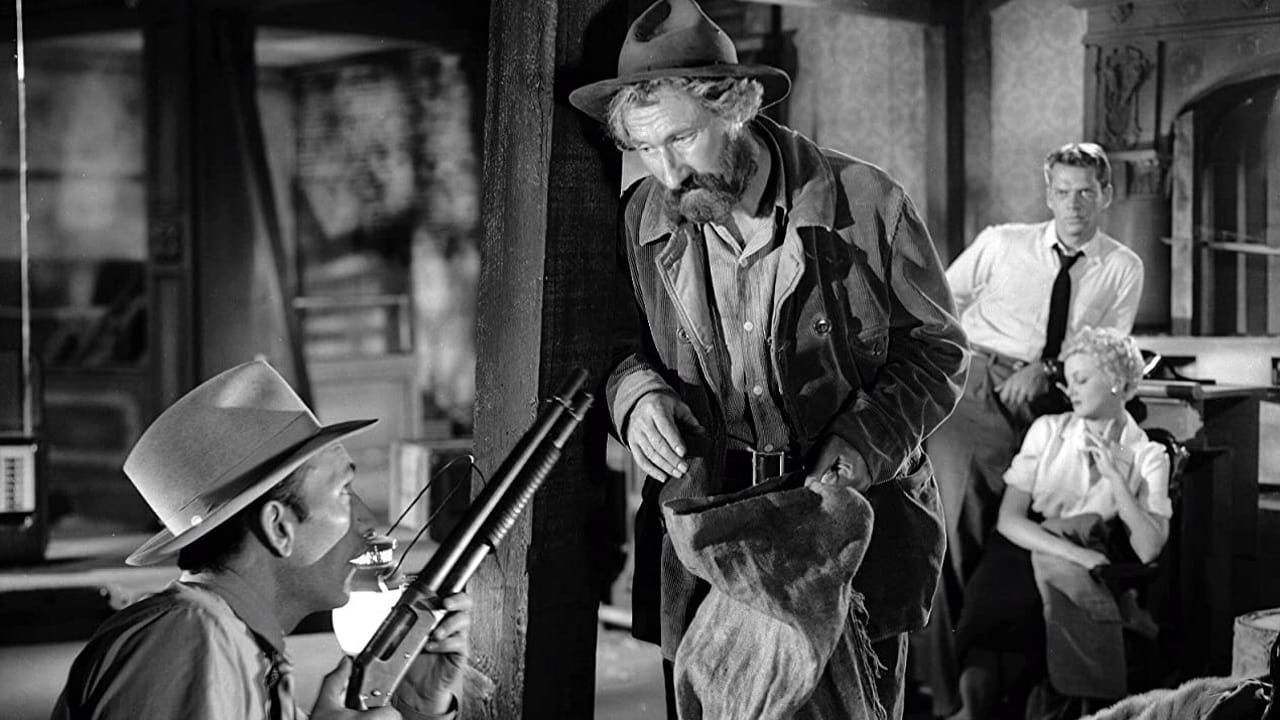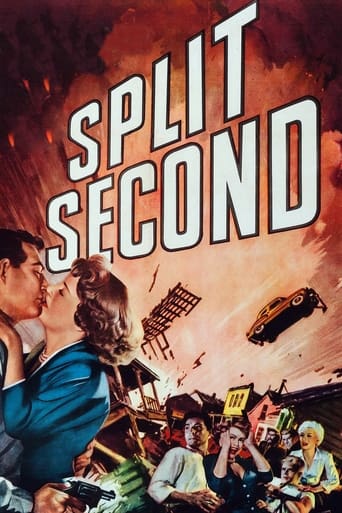

Good start, but then it gets ruined
... View MoreBetter Late Then Never
... View MoreAmazing worth wacthing. So good. Biased but well made with many good points.
... View MoreI enjoyed watching this film and would recommend other to give it a try , (as I am) but this movie, although enjoyable to watch due to the better than average acting fails to add anything new to its storyline that is all too familiar to these types of movies.
... View MoreJust off the top of my head, I can think of three Humphrey Bogart films that are highly reminiscent of "Split Second"--"The Petrified Forest", "The Desperate Hours" and "Key Largo". Yet, despite this being a very familiar sort of film, there is enough going for it to make it well worth your while.The film begins with a jailbreak. The nation's most wanted man has escaped and he and two other crooks are hiding in the desert--near the nuclear testing grounds in Nevada. Along the way, they take several prisoners and plan on hiding out in the test area until just before the explosion. However, naturally, things don't go quite as planned.As I said above, the idea of a bunch of crooks terrorizing a group of hostages is certainly not new. However, three main things make this worth while. First, the nuclear angle is new--and REALLY pays off great at the end of the film. In fact, the ending is great. Second, Steven McNally is a familiar face as a noir heavy--and here he is at his snarling best. Third, despite McNally's great performance, I really loved the character played by Alexis Smith--there is nothing like it and you just have to see what I mean. So what you have is a very taut film packed with nice performances and a knock-out ending. I might rate it higher, but as I said it's a bit familiar and the middle portion is a bit talky. Still....see this film.
... View MoreThe genre of film-noir can be divided into three eras - generally speaking: the classic era (1940-1945), the postwar era (1945-1953) and the Cold War era (1953-1958-60?). Film-noir was always a genre about fear, moral complexity and desperation. When the WWII film-noir exuded postwar disillusions; the concrete war was over but it was still going on on social level: in our minds and in the society. What genre would fit more perfectly to the ages of paranoia and fear than the genre of them, film-noir. To my mind Split Second is the first Cold War film-noir - a statement which one could argue about because in the same year 1953 Samuel Fuller made a film-noir about paranoia and the fear of communism Pickup on South Street (1953).Dick Powell was the star of the Hollywood musicals in 1930's. In 1940's he tried to change his image from a singing dancer to the new bad boy of Hollywood. In 1944 Edward Dmytryk directed Murder, My Sweet based on a novel by Raymond Chandler and casted Dick Powell to play Philip Marlowe - the greatest private eye of film-noir, but the performance by Powell is often left in the shadows of Humphrey Bogart's Philip Marlowe interpretation in The Big Sleep (1946). After the war Dick Powell had some experience from film-noir and he chose to try directing as well. Split Second was his debut of the six films he directed and I think he succeed quite well in it.1950's was the age when the government of the United States made a lot of nuclear weapon experiments: in the deserts of US and in the famous Bikini island. This offered a chance to make a thriller around these kind of events and Split Second represents the attempt of transforming film-noir from its usual big city milieus to a deserted town in Nevada under the fear of the war. Three men have just escaped from prison, unaware of the nuclear experiments of the government. Soon the group of three takes a few hostages in result of getting a doctor because one of the escapees is injured. As time goes on in the deserted town the hostages start to lose their morality and the time before the explosion is running out.The aesthetics of film-noir were often related to big cities like New York or Los Angeles and exotic milieus were always part of the genre but usually they meant bars in Chinatown, motels of Arabia or the cold streets of Shanghai. In 1950's many tried to transform film-noir to new milieus: to snowy conditions (On Dangerous Ground), to the narrow halls of a train (The Narrow Margin) and to the back seats of a car (The Hitch-Hiker). To me Split Second represents the attempt of transforming film-noir to deserted towns, which The Hitch-Hiker (1953) did as well, but Split Second also tried to bring film-noir to the Atomic Age.There's no question whether this is a high quality noir or a B-class film. The latter can be seen in its conventional direction, low budget and it has got a great number of unknown actors. But the way I see it Split Second is alongside with all the b-class Mitchum films one of the bests. It's a great example of Cold War films and how the Atomic Age affected cinema. It's an entertaining thriller but also a fine survey of the disappearance of morality.
... View MoreMost movies about villains holding hostages are like "Dial 1119", in which the police surround the subject building and try to negotiate with the kidnappers. Here, there are no police officers even close to the hostage scene--but everybody's in the blast zone of a planned nuclear test! Ultra-bad guy and prison escapee Sam Hurley (Stephen McNally, who played about the best bad guy in movie history), his accomplice Bart Moore (Paul Kelly) and mute henchman Dummy (Frank DeKova) kidnap several innocent people and hole up in a desert ghost town. Moore is wounded, so physician Neal Garven (Richard Egan) is summoned to tend to Bart. Grizzled prospector Asa Tremaine (Arthur Hunnicutt--who else?) blunders into the situation. All are held hostage while Garven operates on Moore...all the time, everyone knows that a nuclear test is scheduled in just a few short hours.Dummy is overcome and beaten up, just as Hurley, Kelly, and their moll take off in a car, trying to outrun the blast. Well, they don't make it...and end up satisfyingly incinerated by the blast. Tremaine leads the former hostages to an abandoned mine, where the group rides out the bomb detonation.I've always liked any movie that stars Richard Egan (although he plays a supporting character here), and Arthur Hunnicutt is worth the price of admission in his signature role as an old miner. Look fast for Nelson Leigh as a scientist in a control room. Dick Powell directs with a sure hand in his directing debut, and confines most of the story to one claustrophobic room in the abandoned town. Catch this film if you get a chance--the plot is familiar, but the cast and story twist concerning the nuclear test makes it all worthwhile.
... View MoreEscaped convicts take a group of hostages into a ghost town in the Nevada desert that will be ground zero for a nuclear bomb test early the next morning. Stephen McNalley's ruthless criminal hits some unexpected high points during the long night, gunning one man down, and later tossing a Bible he was reading from on the floor, but perhaps the film's best part is that played by Alexis Smith as an unhappy wife who's abandoned her doctor husband. Even though the film is full of bad lines, director Dick Powell has still managed to make it interesting, and ultimately exciting, with an absolutely terrific ending as the anticipated nuclear experiment takes place with everyone running for their lives.
... View More